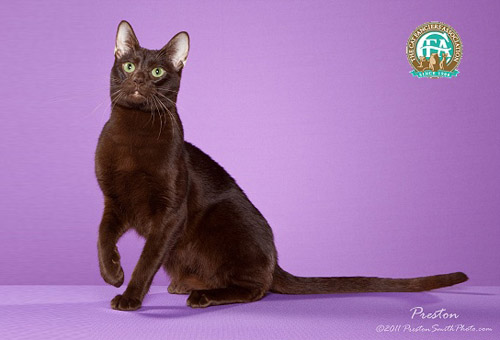


The first Havana Brown was imported into North America in the mid 1950’s. The breed was accepted for registration by CFA in 1959 and was granted Championship status in 1964. Records and old pedigrees reveal that some North American breeders introduced Russian Blues and Siamese into their early breeding programs. This practice came to an end when the breed was closed to outcross breeding in 1974. In England, the Havana has tended to follow the type of the Siamese and the word “brown” has been dropped from the breed name while breeders in North America have maintained the name and the look of the early imports In 1998, in an effort to increase the gene pool, breeders received approval from CFA to open the breed to outcross breeding to unregistered black or blue domestic shorthairs or certain colors of Oriental Shorthairs. In 1999, approval was also received for the use of chocolate point or seal point Siamese with full Havana Browns. CFA’s 8th Best Cat in Championship for the 2004-2005 show season (the cat pictured on the front cover at the top of this pamphlet) is a product of the outcross program. This beautiful male, along with his achievement, is a true testament to the success of the program. What makes a Havana Brown unique? The first thing an admirer notices is the glistening mahogany-toned glossy brown coat. The coat is smooth, lustrous, closelying and feels like a luxurious mink. A rich, evenly colored shade of warm chocolate brown tending more to redbrown is desirable. Their other incomparable feature is the distinctive head that is slightly longer than it is wide. In profile, the prominent broad nose has a definite stop at the eyes. A pronounced whisker pinch combined with the strong square chin forms a somewhat rounded muzzle. Viewed from above or felt with the fingertips, the pronounced break in the bone structure behind each whisker pad is evident in good specimens. The enticing green, oval-shaped eyes in combination with large, forward tilted ears contribute to their alert sweet expression.  Pictured: Third Best of Breed GC, RW SOESTHILL T TEXAS TYLER, Havana Brown Male Photo: © Preston Picking up a Havana Brown for the first time can be a surprising experience, as this lithe-looking cat weighs more than it appears. Its medium-sized body must be firm and muscular, exhibiting a sense of power, yet also exhibit elegance and gracefulness. Males tend to be larger than their female counterparts, usually weighing around eight to ten pounds, while the females average six to eight. Several theories exist as to how the breed got its name. Some historians insist it was named after the rabbit of the same color; however, most Havana Brown fans choose to believe that the breed name refers to the color of a fine Havana cigar. Kittens are born brown, all brown. Ghost tabby markings are allowed in kittens; however, the ideal is a solid color coat free of any markings whatsoever. Whiskers must be brown to complement the coat color. The Havana Brown has a charming, playful manner and a soft, intimate voice. They often extend a paw as a means of contact or attempt to gain the attention of passersby as well as using their paws to investigate curiosities by touching and feeling. A people-oriented breed, they quietly demand human companionship and adapt to most situations. This is the perfect cat for the person who wants a sociable, affectionate and intelligent feline friend. A cat who is as sweet in appearance and color as…chocolate. Pricing on Havana Browns usually depends on type, applicable markings and bloodlines distinguished by Grand Champion (GC), National Regional winning parentage (NW or RW) or of Distinguished Merit parentage (DM). The DM title is achieved by the dam (mother) having produced five CFA grand champion/premier (alter) or DM offspring, or sire (father) having produced fifteen CFA grand champion/premier or DM offspring. Usually breeders make kittens available between twelve and sixteen weeks of age. After twelve weeks, kittens have had their basic inoculations and developed the physical and social stability needed for a new environment, showing, or being transported by air. Keeping such a rare treasure indoors, neutering or spaying and providing acceptable surfaces (e.g. scratching posts) for the natural behavior of scratching (CFA disapproves of declawing or tendonectomy surgery) are essential elements for maintaining a healthy, long and joyful life. There are CFA clubs devoted to the promotion, protection and preservation of the Havana Brown breed. For more information, please send inquiries to CFA at cfa@cfa.org. Text: Norma Placchi Last Updated: Friday, June 18, 2010
|